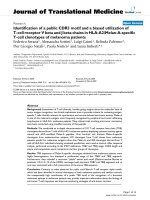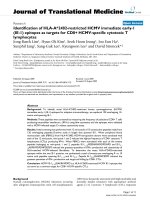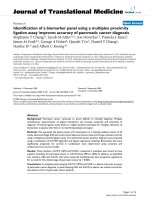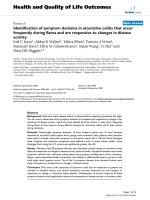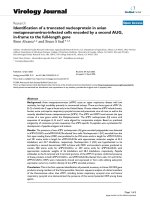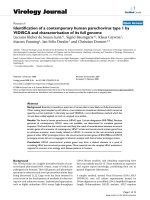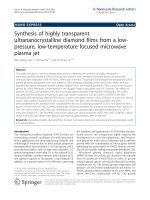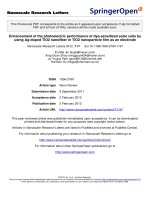Báo cáo toán học: "Identification of mosquito larvicidal bacterial strains isolated from north Sinai in Egypt" pot
Bạn đang xem bản rút gọn của tài liệu. Xem và tải ngay bản đầy đủ của tài liệu tại đây (759.63 KB, 33 trang )
This Provisional PDF corresponds to the article as it appeared upon acceptance. Fully formatted
PDF and full text (HTML) versions will be made available soon.
Identification of mosquito larvicidal bacterial strains isolated from north Sinai in
Egypt
AMB Express 2012, 2:9 doi:10.1186/2191-0855-2-9
Ferial M Rashad ()
Waleed D Saleh ()
M Nasr ()
Hayam M Fathy ()
ISSN 2191-0855
Article type Original
Submission date 19 November 2011
Acceptance date 26 January 2012
Publication date 26 January 2012
Article URL />This peer-reviewed article was published immediately upon acceptance. It can be downloaded,
printed and distributed freely for any purposes (see copyright notice below).
Articles in AMB Express are listed in PubMed and archived at PubMed Central.
For information about publishing your research in AMB Express go to
/>For information about other SpringerOpen publications go to
AMB Express
© 2012 Rashad et al. ; licensee Springer.
This is an open access article distributed under the terms of the Creative Commons Attribution License ( />which permits unrestricted use, distribution, and reproduction in any medium, provided the original work is properly cited.
Identification of mosquito larvicidal bacterial strains isolated from north Sinai in Egypt
Ferial M Rashad *
1
, Waleed D Saleh
1
, M Nasr
2
, Hayam M Fathy
1
1
Department of Microbiology, Faculty of Agriculture, Cairo University, Giza 12613, Egypt
2
Department of Microbiology, National Center for Radiation Research and Technology, Nasr
city 11371, Egypt
* Corresponding author:
Email addresses:
WDS:
MN:
HMF:
Abstract
In the present study, two of the most toxic bacterial strains of Bacillus sphaericus
against mosquito were identified with the most recent genetic techniques. The PCR product
profiles indicated the presence of genes encoding Bin A, Bin B and Mtx1 in all analyzed
strains; they are consistent with protein profiles. The preliminary bioinformatics analysis of
the binary toxin genes sequence revealed that the open reading frames had high similarities
when matched with nucleotides sequence in the database of other B. sphaericus strains. The
biological activity of B. sphaericus strains varied according to growing medium, and
cultivation time. The highest yield of viable counts, spores and larvicidal protein were
attained after 5 days. Poly (P) medium achieved the highest yield of growth, sporulation,
protein and larvicidal activity for all tested strains compared to the other tested media. The
larvicidal protein produced by local strains (B. sphaericus EMCC 1931 and EMCC 1932) in
P medium was more lethal against the 3
rd
instar larvae of Culex pipiens than that of reference
strains (B. sphaericus 1593 and B. sphaericus 2297). The obtained results revealed that P
medium was the most effective medium and will be used in future work in order to optimize
large scale production of biocide by the locally isolated Bacillus sphaericus strains.
2
Keywords: Bacillus sphaericus, PCR, Sequencing, Conventional media, Culex pipiens,
Larvicidal activity.
ــــــــ
Introduction
Mosquito borne diseases constitute a serious health hazard to human. It has been
established that, mosquito’s females as blood sucking insects, are vectors of a multitude
disease of man and animals in different countries through transmission of pathogenic agents.
Mosquitoes are belonging to the order Diptera and family Culicidae which include the genera
of medical importance, Aedes, Anopheles, Culex and Mansonia. At least 90% of the world
malaria (Anopheles), yellow fever (Aedes), dengue (Aedes), encephalitides (Aedes) and
lymphatic filariasis (Aedes, Anopheles and Culex) occurs in the tropics where the
environmental conditions favor insect vectors responsible for the transmission of diseases
(Rawlins, 1989).
Controlling insect populations with chemical insecticides has proven useful. Over
time, mosquitoes developed resistance to chemical insecticides, toxicity to non target
organisms, increased public awareness of the toxicity hazards, undermined this control
strategy's efficacy. Within this scenario, biological control based on insecticidal bacteria has
proven effective in controlling insect vectors. Mosquitocidal Bacillus thuringiensis subsp.
israelensis and Bacillus sphaericus are used as an alternative for synthetic chemical
insecticide in controlling larvae of mosquitoes over two decades. B. thuringiensis subsp.
israelensis has a wider spectrum of activities against Anopheles, Culex and Aedes spp; while
the target spectrum of B. sphaericus is restricted mainly to Culex, for a lesser extent to
Anopheles and only few Aedes species. Compared to B. thuringiensis subsp. israelensis, the
popular microbial mosquito control agent, B. sphaericus has major advantage. It appears to
persist in the environment longer especially in polluted water, and thus can establish a longer
lasting control of larval populations.
3
The toxicity of B. sphaericus strains is mainly attributed to the presence of binary
toxin (Bin A, Bin B) and/or mosquitocidal (Mtx) toxin genes. Binary toxin is comprised of two
polypeptides of 42- and 51-kDa and produced during sporulation. The other group of toxins
(mtx1, mtx2, mtx3) is produced during vegetative growth. Highly toxic strains of B.
sphaericus contains btx as principle factor or both btx and mtx, whereas the weakly toxic
strains only contain mtx genes (Charles et al., 1996).
Despite the excellent performance of B. sphaericus in the field, the presence of only
the Bin toxin in spores as the major toxic moiety of commercial preparation has allowed
insects to develop resistance (Yuan et al., 2000) that may limit its application or necessitate
rotation with other insecticides.
A program on biological control of mosquitoes, virulence prospecting and evaluation
of new isolates around the world is one of the most important steps taken to determine their
effect on target populations and thereby selecting the most promising strains for producing
biological insecticides (Litaiff et al., 2008). Since the use of locally available effective strains
are always advisable in insect control programs, the search for more effective strains able to
overcome this resistance should be continued with emphasis on the isolation of more toxic
strains. In an earlier study, Fathy (2002) isolated and morphologically and biochemically
characterized a number of highly toxic bacterial strains against mosquito. The aim of the
present investigation is to further identify two potent of the isolated strains using modern
genetic techniques. Selection of the best medium that markedly supports active cell growth
and high biocide production yield will also be considered.
Materials and methods
Microorganisms
Two actively marked toxic strains of Bacillus sphaericus (Fathy, 2002), previously
isolated from the soil of north Sinai in Egypt, identified morphologically, biochemically and
assayed biologically against mosquito larvae (strains are available in Culture collection of
4
Cairo “MIRCIN” under numbers EMCC 1931 and EMCC 1932, Agric. Faculty, Ain Shams
University). They were used in the present study along with the reference strains of B.
sphaericus 1593 and 2297 as highly toxic strains (Charles et al., 1996). The reference strains,
B. sphaericus1593 and B. sphaericus 2297, were kindly provided by Prof. Dr. Y. A. Osman,
Mansoura University and Prof. Dr. M. S. Foda, National Research Center, respectively.
Maintenance of microorganisms: Stock cultures were maintained in heavy spore
suspensions at 4° C until required.
Characterization of the selected local strains
Polymerase chain reaction and primer sequences
Purification of genomic DNA: Total DNA was prepared from bacterial strains according to
the methodology of Sambrook et al. (1989). Each B. sphaericus strain was grown overnight
in a 100 ml of Luria Bertani LB medium (Bertani, 1951) at 30° C. Cells were harvested by
centrifugation at 6000 rpm and 4° C for 10 min and washed with distilled water. The pellets
were frozen at – 80° C for 1 h then thawed at 37˚ C; resuspended in 5ml of solution
containing 2mg / ml lysozyme and incubated for 1h at 37° C. Then, 0.5 ml of sodium dodecyl
sulphate, SDS, (1%) was added and the solution was left for 15 min at room temperature. The
cell lysate was mixed with equal volume of phenol/chloroform and kept on ice for 5 min
followed by spinning for 20 min at 10000 rpm and 4° C. The supernatant that contains the
DNA is mixed again with equal volume of phenol/chloroform for 5 min on ice to get rid of
any remaining proteins and respinning for 20 min at 10000 rpm and 4° C. Afterward, 0.1
volume of sodium acetate (3M) and 2.5 volume of absolute ethanol was added. DNA was
collected by centrifugation and the pellet was dried and washed with 70% ethanol. The DNA
pellet was collected again, dried and 50µl TE buffer was added and mixed well. Finally, 10µl
of RNase was added to the DNA solution and left at 37° C for 2 days in order to remove any
contaminating RNA.
5
Primer: According to the published sequences of the B. sphaericus toxin genes
(Shanmugavelu et al., 1995), sequences for three sets of primers of the toxin genes were
selected; synthesized and obtained from Biobasic, Canada and then used for PCR
amplification. The sequences of three pairs of specific primers were used to identify genes Bin
A, Bin B that encode binary toxins (41.9 and 51.4 kDa) and gene Mtx1 that encode
mosquitocidal toxin, 100 kDa; the expected size of amplified products are shown in Table 1.
The suspensions of genomic DNAs were transferred to 25 µl of PCR-reaction mixture
containing 0.5µM of each primer, 0.2 mM of each dNTP, 1x of Taq polymerase buffer, 1.5
mM MgCl
2
and 2.5U of Taq polymerase (Red Hot). The PCR amplifications were performed
as follows: initial denaturation of DNA at 94°
C for 5 min, 35 cycles comprised of 1
min denaturation at 94°
C, 1 min annealing at 55° C, 2 min elongation step at 72°
C followed
by a final extension step at 72
o
C for seven min. Amplicons were visualized by electrophoresis
on 1% agarose gel stained with ethidium bromide. The banding was visualized at short UV
light (Carozzi et al., 1991).
Sequence analysis: The dideoxyribonucleoside chain termination procedure originally
developed by Sanger et al. (1977) was employed for sequencing the double-stranded DNA
obtained during the PCR. Sequencing was conducted under BigDyeTM terminator cycling
condition. The reacted products were purified using Ethanol Precipitation and run using
Automatic Sequencer 3730xl (Macrogen, DNA sequencing, USA). The nucleotide sequence
data of the Bin toxins open reading frame was submitted to the BLASTN programs search
nucleotide data bases
().
Sequencing the DNA alignments encoding binary toxins were performed according to
EXPASY Proteomics Server (Expert Protein Analysis System) proteomics server of the Swiss
Institute of Bioinformatics (SIB). (). The partial DNA sequences for
Bin A and B from the local strains (Bacillus sphaericus EMCC 1931 and 1932) were assigned
6
GenBank accession nos. JN007909, JN0079010 and JN0079011, JN0079012 for B.
sphaericus EMCC 1931 and B. sphaericus EMCC 1932, respectively.
Protein profile analysis
The most commonly method of analysis and separation of protein is sodium dodecyle
sulfate-polyacrylamide gel electrophoresis (SDS-PAGE) which based on the relative
molecular weight of protein (Laemmli, 1970). For each strain of B. sphaericus, protein
analysis was made for both 18 and 120 h cultures. Samples of whole cultures were
centrifuged at 6000 rpm and 4° C for 10 min; then the pellets were harvested and washed
three times using distilled water (6,000 rpm /10 min /4° C). The pellets resuspended in an
equal volume of loaded buffer followed by scratching and heating at 100° C for 5 min., the
extracts were clarified by centrifugation at 10,000 rpm for 10 min; the supernatants were
injected in polyacrylamide gel for protein separation.
The separating gel solution was prepared and poured into the gel apparatus between
the cleaned glass plates. The gel solution was immediately overlaid with water and allowed to
polymerize at room temperature for 45-60 min, then water was removed. Stacking gel
solution was prepared, poured over the separating gel and allowed to polymerize for 30- 45
min. Polyacrylamide gels were stained in Coomassie brilliant blue solution with gentle
shaking for up to 3 h at room temperature.
Separation was done using Mini-Protein II electrophoresis unit at 200V, constant
voltage for approximately 45 min in SDS-electrophoresis buffer. The gel was destained by
incubation in several volumes of Coomassie brilliant blue destain solution for up to 8 h at
room temperature. Proteins were detected as blue-stained bands against clear background.
Protein profile analysis
was carried out using Gel Documentation System (Alpha Image
2000), Germany.
Cell growth and toxin production by bacterial strains in various cultivation media
7
B. sphaericus strains were grown on nutrient agar slants at 30ْ C for 72 hr. Seed
cultures were carried out following the technique of Obeta and Okafor (1983). The slant
cultures were washed with 5.0 ml sterile distilled water, which were then added to 250 ml
flasks containing 50 ml nutrient broth. The flasks were placed on a rotary shaker at 200 rpm
and incubated for 24 hr at 30ْ C. From these first- passage seed cultures, 5.0 ml were used to
inoculate similar seed flasks and treated as above for 18h.
Five conventional laboratory media that have been recommended as reference media
by many authors were used for B. sphaericus production as follow: Glucose-Glutamate-Salts-
EDTA (GGSE medium), Chan et al. (1972), g/l, glucose 5, monosodium glutamate 10,
K
2
HPO
4
0.5, KH
2
PO
4
0.5, MgSO
4
.7H
2
O 0.2, FeSO
4
.7H
2
O 0.01, MnSO
4
.4H
2
O 0.01,
ZnSO
4
.7H
2
O 0.013, CaCl
2
0.025, thiamine 0.0005, biotin 1µg, EDTA 25 µg/ml; Nutrient
Yeast Extract Salt (NYS medium) without glucose, Yousten and Davidson (1982), g/l,
peptone 5, beef extract 3, yeast extract 0.5, MnCl
2
0.01, CaCl
2
0.1, MgCl
2
0.2 ; Poly (P
medium), Bourgouin et al. (1984), g/l, peptone 5, beef extract 5, yeast extract 10, glycerol 10,
NaCl, 3; Acetate Yeast Extract (AYE medium), Sasaki et al. (1998), g/l ,sodium acetate 5.45,
yeast extract 10, MnCl
2
. 4H
2
O 0.02, CaCl
2
. 2H
2
O 0.2, MgCl
2
. 6H
2
O, 1.02, KH
2
PO
4
0.5 and
Luria Bertani (LB medium), Poopathi et al. (2002) g/l, peptone 5, yeast extract 2.5, NaCl 5.
The pH of all media was adjusted to 7.1± 0.1 with 1N NaOH, and the media were dispensed
in flasks as 20% v/v and sterilized at 121ْ C for 20 min.
Production flasks of each medium were inoculated in triplicate with 1.0 ml (2% v/v,
Prabakaran et al., 2007) of a second passage seed culture of each B. sphaericus strains and
allowed to grow at 30ْ C for 5 days on a rotary shaker (Cole Parmer, 51604) at 200 rpm.
Culture samples were drawn from each culture medium at 0, 1, 3 and 5 days intervals .
Total viable and spore counts: Serial decimal dilutions of culture samples were prepared;
1ml of each dilution (in triplicates) was added to Petri dish, followed by addition of nutrient
agar medium. For spore counts, the serial dilutions of culture samples were pasteurized at 80ْ
8
C for 15 min before plating. Plates were incubated at 30ْ C for 48h and the developing B.
sphaericus colonies were counted and expressed as cfu/ml and/or spores/ml. The pH of
culture samples were estimated using a digital pH meter (JEN WAY, 3305).
Biochemical studies and toxicity bioassay: Whole culture samples for each strain on
different media were centrifuged at 6000 rpm and 4° C for 10 min and washed twice with
distilled water. The pellets resuspended in distilled water and used for protein determination
and toxicity bioassay.
Protein determination: Protein extracts were prepared by adding 25 µl of 2M NaOH
solution to each ml suspension followed by incubation at 37 ْC for 3hr (Sasaki et al., 1998).
After centrifugation and extraction as mentioned above, protein concentrations in the clarified
supernatant were determined using the technique of Bradford (1976) with bovine serum
albumin (BSA, Sigma) as standard.
Bioassay against Culex pipiens larvae
The Culex pipiens 3
rd
instar larvae were obtained from mosquito rearing laboratory in
Research Institute of Medical Entomology, Ministry of Health. Serial dilutions of the
previously resuspended pellets were prepared in distilled water, and then one ml of each
dilution was added to 100 ml distilled water in 200 ml plastic cups. Twenty, 3
rd
instar larvae
of C. pipiens were placed in each cup and suitable amount of larval food was added (ground
dried bread: dried Brewer's yeast as 2:1). Experiments were conducted at room temperature of
28° C± 2. Each experiment included 3 concentrations in triplicates, as well as appropriate
control. Larval mortality was scored after 48 h and corrected (if needed) for control mortality
using Abbott's formula (Abbott, 1925).
Statistical analysis
All data were statistically analyzed using Factorial ANOVA test (MSTAT-C Version 4, 1987)
Results
Characterization of the locally isolated strains
9
Detection of toxin genes by Polymerase chain reaction (PCR)
The expected sizes of the PCR products were 1.1, 1.3 and 2.6 kb for Bin A, Bin B and
Mtx1 toxin genes, respectively. As shown in Fig. (1a, b and c), the primer designed for each
gene amplified the target toxin gene as the amplicon obtained was of the expected size. The
PCR product profiles of the local strains (Bacillus sphaericus EMCC 1931 and EMCC 1932)
are identical to those of the reference strains, B. sphaericus1593 and B. sphaericus 2297.
Analysis of these profiles proved that both the standard and local strains harbor the Bin A, Bin
B and Mtx1 genes encoding Bin A 42-, Bin B 51- and Mtx1 100-kDa proteins.
Sequencing of the binary toxin gene operons from local strains
The preliminary bioinformatics analysis of the binary toxin genes sequence revealed
that the open reading frames had high similarities when matched with nucleotides sequence in
the database of other B. sphaericus strains. Based on linear DNA sequences of Bin A (737 bp
and 348 bp) and Bin B (513 bp and 373 bp) of local strains (B. sphaericus EMCC 1931 and
EMCC 1932) respectively, the phylogenetic trees (Fig. 2 & 3) were constructed. Genetically,
Bin A and B gene operons from the local strain B. sphaericus EMCC 1931 were found to be
close to those from other B. sphaericus strains with at least 94% similarities. However, the
sequences of binary toxin gene operons from the other local strain B. sphaericus EMCC 1932
revealed lower similarity (only 81% for Bin A and 89% for Bin B genes). The locus sequences
of DNA linear Bin A and Bin B binary toxin genes, partial cds were deposited in the
GenBank under the accession numbers JN007909, JN0079010, and JN0079011, JN0079012
for B. sphaericus EMCC 1931 and EMCC 1932, respectively.
Derived from the nucleotide sequence of the DNA fragments encoding the 42- and 51-kDa
toxin proteins of the local strains (B. sphaericus EMCC 1931 and EMCC 1932), the amino
acid sequences were deduced and shown below the nucleotide sequence; the constructed
similarity trees were drawn (Fig. 4 & 5). It is apparent that the 42- and 51-kDa toxin proteins
in local strains have high levels of similarity when matched with protein in binary toxins in
10
the database. A significant homology of 95 % was found between the amino acid sequence of
the B. sphaericus EMCC 1931 protein and the 42- kDa toxin over a stretch of 283 amino
acids. This percentage of identity was markedly decreased to 81 % in case of the protein
produced from B. sphaericus EMCC 1932 strain over 254 amino acids. With respect to 51-
kDa toxin protein, the amino acid sequence obtained from the B. sphaericus EMCC 1931
protein recorded a similarity percentage of 94, overall 279 amino acids. On the other hand,
this similarity decreased to record 89 % with the second strain, B. sphaericus EMCC 1932,
with 268 amino acids .
Analysis of protein profiles by SDS-PAGE
The protein patterns of the local (B. sphaericus EMCC 1931 and EMCC 1932) and
reference (B. sphaericus 1593 and B. sphaericus 2297) strains resulting from SDS-PAGE
(Fig. 6) showed that numerous molecular weights of proteins were detected for both 18 and
120 h cultivation. The protein fractions separated along 9 – >17 bands with molecular weights
ranged from 20- to 139- kDa were quantitatively differed as estimated from their migration in
SDS-PAGE, densitographs (Figs. 7 & 8). The high molecular mass protein bands over the
range of 128- to 139- kDa were detected in all lanes from 18 and 120 h cultures, however,
disappeared after 120 h only in the culture of B. sphaericus EMCC 1931. Also, bands of
protein fractions with 110- to 125-kDa were found in the lanes of all cultures during the
vegetative growth and after the completion of sporulation. Only two bands of protein fractions
with molecular weight 100- to 107-kDa were found in the lane of 18 h culture of the strain B.
sphaericus EMCC 1931. An additional bands at about 90 – 94-, 82 – 85-, 67– 78-, 54 – 63-,
40 – 48-, 30 – 38- <20 -29 kDa were observed in all lanes with minor exceptions between 18
and 120 h.
Cell growth and toxin production by bacterial strains in various cultivation media
Regarding, the overall growth and toxin production in the tested laboratory media, it is
palpable that the viable counts of B. sphaericus strains varied according to growing medium,
11
P medium had the highest viable counts for all strains throughout the cultivation time (Fig.
9). After 24 h cultivation, P medium achieved the highest significant counts (8.7 × 10
8
- 1.2 ×
10
9
cfu / ml), however no significant differences could be observed between the other tested
media. Increasing cultivation time up to 72 h resulted in increasing growth yield; P medium
was still the best medium supporting the growth of different B. sphaericus strains (about 43 -
300 fold over the other tested media). After 5 days and at the end of the cultivation course, the
viable counts of different strains, to some extent, remained stable in P medium, but they
increased in the other tested media with multiplication rates ranged from 1.25 to 58.3 fold.
NYS medium attained the highest significant yield of 1.1 - 1.3 × 10
9
cfu / ml
and
stand with P
medium without
significant differences. GGSE medium (2.0 × 10
8
– 1.0 × 10
9
cfu /ml), LB
medium (1.2 – 2.7 × 10
8
cfu /ml) and AYE medium (1.0 – 1.8 × 10
8
cfu / ml) came after
(Fig. 9).
Sporulation rate was generally at low levels after 24 h in all tested media, P medium
recorded the lowest significant rate (1.3 – 1.7 %), although it attained the highest viable spore
counts. After 72 h, sporulation rate was still low (Fig. 9) and significant differences were
observed within the tested strains in P medium and between P medium and the other tested
media. Consequently, the maximum yield of spores was reached at the end of the cultivation
time in both P medium and NYS medium (1.0 – 1.4 × 10
9
spores / ml) followed by GGSE
medium (1.1- 8.0 × 10
8
spores / ml), however, the highest significant sporulation rate (88.5 -
100%) was obtained in NYS medium followed by P medium and GGSE medium (71.4 –
93.3%), (40.0 – 80%) in that order. There were no significant differences between the local
(B. sphaericus EMCC1931) and the reference (B. sphaericus 2297) strains but they varied
significantly with the other tested strains (Fig. 9).
Protein was produced after 24 h in the cultivation media except in GGSE medium and
AYE medium, whereas it was produced lately. Protein was in increasing order along the
cultivation course. The highest significant quantities were attained in P medium by the local
12
strains (B. sphaericus EMCC 1931 and EMCC 1932) by 5 days (Fig. 10 a). Generally, the
quantities of produced protein differed significantly among the tested media and strains along
the cultivation time. Local strain, EMCC 1931 always produced significantly higher protein
amounts in cultivation media than standard strains 2297and 1593.
The larvicidal activities of the tested strains were performed with toxins produced
from different laboratory media; the lethal concentrations were expressed as nanogram of
produced protein / ml. The comparative toxicities of B. sphaericus strains produced from five
culture media are shown in Fig. (10 b). It is clearly observed that protein produced by local
strains (Bacillus sphaericus EMCC 1931 and EMCC 1932) in P and NYS media was more
lethal than that of reference strains (B. sphaericus1593 and B. sphaericus 2297). The lowest
LC
50
values of 2.5, 3.2, 12 and 13.8 ng / ml were achieved in poly medium after the 5
th
day
by B. sphaericus strains EMCC 1931, EMCC 1932, 1593 and 2297, respectively, against the
3
rd
instar larvae of Culex pipiens (Fig. 10 b). However, the LC
50
values of 4.4, 4.8, 6.1 and 7.2
ng / ml were obtained in NYS medium, in that order.
Significant differences in toxicity against mosquito larvae were observed between P
and NYS media, local (Bacillus sphaericus EMCC 1931, EMCC 1932) and reference (B.
sphaericus1593, B. sphaericus 2297) strains. With the rest of media, significant differences
were observed between all tested strains and media. The lowest toxicity was observed in LB
and AYE medium, respectively.
pH values was in increasing order in all cultivation media as a result of the growth of
different strains. The values of final pH in all tested cultures ranged between 8.4 and 9.0.
Discussion
Since the use of locally available effective bacterial strains is always advisable in
insect control programs, it should be genetically analyzed to screen the presence of newer or
perhaps more toxic stains. The PCR analysis of new isolates provides a valuable prescreen
that permits their prioritization for subsequent insect assays.
13
In the current study, PCR analysis proved that both the standard 1593, 2297 and local
EMCC 1931, EMCC1932 strains of B. sphaericus harbor the BinA, BinB and Mtx1 genes
encoding Bin A 42-, Bin B 51- and Mtx1 100-KDa proteins. This result is in accordance with
the information provided for BinA, BinB and Mtx1 toxin genes (Shanmugavelu et al., 1995;
Charles et al., 1996; Otsuki et al., 1997); and the description of B. Sphaericus 2297 and 1593
as highly toxic strains. Binary toxin genes are considered major factors for mosquito
larvicidal activity. More recently, Jagtap et al. (2009) proved that the highly toxic B.
Sphaericus 2297 and 1593 strains have five toxin genes encoding mosquito larvicidal toxins,
namely BinA, BinB, Mtx1, Mtx2 and Mtx3.
The obtained bioassay results confirmed the superiority of the locally isolated strains
compared to the two reference strains with respect to toxicity against mosquito larvae. To
assess whether this toxic activity is attributed to a new variant of the bin operon, the amplified
PCR products of bin genes were sequenced. Based on bioinformatics analysis, the overall
nucleotide and protein similarities veritably indicated that both B. sphaericus EMCC 1931
and EMCC 1932 are most similar to B. sphaericus strains 9002, IAB88, IAB872,
Lysinobacillus sphaericus ISPC-8, H-25 group and 2297. This result is the same as what
previously reported by many authors (Aquino de Muro and Priest, 1994; Bei et al., 2006; Hu
et al., 2008).
Toxicity for mosquito larvae has been associated with the formation of toxic proteins
during sporulation and/or vegetative growth.
As revealed by SDS-PAGE, the local strains
(Bacillus sphaericus EMCC 1931 and EMCC 1932) have relatively similar protein profiles
(20- to -139 KDa) either during vegetative growth or sporulation with minor exceptions. This
finding, to some extent, is in accordance with that obtained early by Baumann et al. (1985).
They found that solubilization of the preparations at pH 12 with NaOH led to the elimination
of all high molecular mass bands but 43- and 63-KDa were not. Other than recently, Smith et
14
al. (2005) observed the presence of 110 and 125-KDa SDS-PAGE bands from NaOH extracts
of washed B. sphaericus spores.
The binary toxin produced by B. sphaericus may be synthesized as 110- 125-KDa
protein which is converted to a non-toxic 63-KDa moiety and a toxic 43-KDa moiety during
the process of sporulation. Additional studies have also shown that the 110- and 125-KDa
bands are attributable to the binary toxin by reaction with anti-binary toxin antibodies. Also, a
40-KDa protein was related to 43-KDa toxin (Baumann et al., 1985; Broadwell and Baumann,
1986; Shanmugavelu et al., 1998; Smith et al., 2005).
Recently, screening of proteins produced by some toxic isolates of B. sphaericus
revealed the presence of a ~ 49 kDa
protein in spore/crystal preparations. The absence of this
protein in other toxic ones to which mosquito resistance has developed, led to the proposal
that this might represent a new toxin that could have an important role in the prevention of
insect resistance (Yuan et al., 2003; Jones et al., 2007). Our results showed that analysis of
protein produced by local strains B. sphaericus EMCC 1931 and EMCC 1932 revealed the
presence ~ 49kDa protein.
Low toxic strains, synthesize toxic proteins during vegetative growth such as 100-,
35.8- and 31-KDa. In the current study, the presence of 100-kDa corresponding to the Mtx1
toxin was observed on SDS-PAGE only in 18 h old culture of EMCC1931 but not in 120 h.
Furthermore, the visualized bands at 30.2- to 38.9- KDa bands in 18 h preparations of all
strains may be ascribed to the Mtx2 and Mtx3. In the preparations of 120 h, the bands with
molecular masses of 30.9- and 31.5-KDa were detected in all strains except B. sphaericus
1593 .
Prominently, the Mtx1 has a different mode of action from the binary toxin, and which
make it an alternative toxin to delay or overcome development of resistance to binary toxin
(Wei et al., 2006). Lately, Rungrod, et al. (2009) demonstrated for the first time that Mtx1
and Mtx2 toxins exhibit synergism against resistant A. aegypti mosquito larvae.
15
From the present results, it is clearly evidenced that media, incubation time and B.
sphaericus strains play a key role in growth, sporulation, protein synthesis and potency.
Prolonging cultivation time up to 5 days actualized the maximum lethal activity and
sporulation rate in all media tested. A steady increase in spore counts along the cultivation
time was observed. Poly medium proved to be the most auspicious medium for the
productivity of B. sphaericus.
In literature, the exact cultivation time for obtaining the maximum productivity of B.
sphaericus strains was conflicting. Some workers found that the maximum level of produced
toxins was obtained through 18 – 24 h and prolonging cultivation time had never resulted in
consistent increase in spore counts or the larvicide yield. However, others observed a
progressive increase in sporulation and toxin production with extending incubation time up to
72 h when B. sphaericus cultivated in NYS medium or up to 9 days under semi solid
cultivation (Myers et al., 1979; Obeta and Okafor, 1983; Bourgouin, 1984; Klein et al., 1989;
Prabakaran et al., 2007; Foda et al., 2003; Poopathi and Abdidha, 2007 and 2008).
The presence of larvicidal activity in purified cell wall of B. sphaericus 1593, 2297
have been observed and attributed to the imperfect separation between cell wall and the
crystals could account for this phenomenon. At the completion of sporulation and toxin
synthesis, the bacterial cells lyse and liberate the spore and the attached toxic parasporal body
(Yousten et al., 1989; Myers and Yousten 1980; Klein et al., 2002). This may explaine the
increasing of toxicity with prolonging cultivation time up to 120 h in the present work.
The comparison between the tested conventional laboratory media indicated that
medium composition has a great effect on the growth, sporulation and biocide production by
B. sphaericus. P medium was found to be the most propitious medium; the proteins released
by local strains (B. sphaericus EMCC 1931 and EMCC 1932) in P medium followed by NYS
medium were more lethal than that produced in the other tested media. White and Lotay
(1980) investigate the nutritional requirements of 27 strains of B. sphaericus. They found that
16
four strains were grown and sporulated in a simple chemically defined minimal medium,
however, the remaining strains needed vitamins or amino acids as well as purine. They also
observed that increasing the acetate concentration did not improve growth. Besides, B.
sphaericus has several important phenotypic properties, including those of being incapable of
carbohydrates utilization and having exclusive metabolic pathways for a wide variety of
organic compounds and amino acids (Russell et al. 1989, Alexander and Priest, 1990; Han et
al., 2007).
Such uneven findings in this study may be, in part, due to the variations in the
composition of the tested media in their contents of carbon and nitrogen sources as well as
minerals; and to the actual nutritional requirements by a certain strain. By grouping the
composition of the five reference media tested in the current study, all media except GGSE
medium containing at least two organic nitrogen sources of beef extract, peptone and yeast
extract; three of them supplemented with glucose, glycerol or acetate as carbon source; some
containing sodium chloride while the others containing Mg
2+
, Mn
2+
, Ca
2+
, Fe
2+
, Zn
2+
and
potassium phosphates. The calculation of the exact concentrations of carbon and nitrogen
(g/l) in each medium used were found to equal, 8.43, 2.4 in P medium; 2.18, 1.22 in NYS
medium; 2.03, 0.3 in GGSE medium; 4.13, 2.1 in LB medium and 3.71, 0.98 in AYE
medium, respectively. P medium has the highest concentrations of C and N which interprets,
in part, the highest yield obtained when all strains were grown in it. The present results gave
an idea about the most effective medium that will be used in further study to optimize the
biocide production and to develop a low cost effective production medium.
Competing interests
The authors declare that they have no competing interests.
Authors' contributions
17
FMR suggested the research problem and outlined research plan, interpreted the data,
prepared the manuscript and have given final approval of the version for publication. All
authors, FMR, WDS, MN and HMF, as a research team, carried out the microbiological
experiments, bioassay tests and protein estimation, protein profile analysis, DNA extraction
matching and submission the sequencing data in the database of gene bank. HMF carried out
statistical analysis and figured data. All authors read and approved the final manuscript.
References
Abbott WS (1925) A method of computing the effectiveness of an insecticide. J Economic
Entomology 18: 265-267.
Alexander B, Priest FG (1990) Numerical classification and identification of Bacillus
sphaericus including some strains pathogenic for mosquito larvae. J General
Microbiology 136: 367-376.
Aquino de Muro M, Priest FG (1994) A colony hybridization procedure for the
identification of squitocidal strains of B. sphaericus on isolation plates. J Invertebrate
Pathology 63: 310-313.
Baumann P, Unterman BM, Baumann L, Broadwell AH, Abbene SJ, Bowditch RD (1985)
Purification of the larvicidal toxin of Bacillus sphaericus and evidence for high
molecular weight precursors. J Bacteriology 163: 738-747.
Bei H, Haizhou L, Xiaomin H, Zhiming Y (2006) Preliminary characterization of a
thermostable DNA polymerase I from a mesophilic Bacillus sphaericus strain C3-41.
Arch Microbiol 186: 203-209.
Bertani L (1951) Studies on lysogenesis. I. The mode of phage liberation by lysogenic
Escherichia coli. J Bacteriology 62: 293-300.
Bourgouin C, Larget TI, de Barjac H (1984) Efficacy of dry powders from B. sphaericus
RB80, a potent reference preparation for biological titration. J Invertebrate Pathology
44: 146-150.
Bradford MM (1976) A rapid and sensitive method for the quantitation of microgram
quantities of protein utilizing the principle of protein-dye binding. Analytical
Biochemistry 72, 248-254.
Broadwell AH, Baumann P (1986) Sporulation- associated activation of Bacillus
sphaericus larvicide. Appl Environmen. Microbiol 52: 758-764.
Carozzi NB, Kramer VC, Warren GW, Evola S, Koziel MG (1991) Prediction of
insecticidal activity of Bacillus thuringiensis strains by polymierase chain reaction
product profiles. Appl Environmen Microbiol 57: 3057-3061.
Chan EC, Rutter PJ, Wills A (1973) Abundant growth and sporulation of Bacillus
18
sphaericus NCA Hoop 1-A-2 in a chemically defined medium. Canadian J
Microbiology 19, 151-154.
Charles J F, Nielsen-LeRoux C, Delecluse A (1996) Bacillus sphaericus toxins:
molecular biology and mode of action. Annual Review of Entomology 41: 451- 472.
Fathy HM (2002) Studies on some biocide-producing microorganisms. M. Sc. Thesis,
Faculty of Agriculture, Cairo University, 274p.
Foda MS, El-Bendary M, Moharam ME (2003) Salient parameters involved in
mosquitocidal toxins production from Bacillus sphaericus by semi-solid substrate
fermentation. Egyptian J Microbiology 38: 229-246.
Han B, Liu H, Hu X, Cai Y, Zheng D, Yuan Z (2007) Molecular characterization
of a glucokinase with broad hexose specificity from Bacillus sphaericus strain C3-41.
Appl Environmen Microbiol 73: 3581-3586.
Hu X. Fan W, Han B, Liu H, Zheng D, Li Q, Dong W, Yan J, Gao M, Berry C, Yuan Z
(2008) Complete genome sequence of the mosquitocidal bacterium Bacillus sphaericus
C3-41 and comparison with closely related Bacillus species. J Bacteriology 190: 2892-
2902.
Jagtap SC, Jagtap CB, Kumar P, Srivastava RB (2009) Detection of Bacillus sphaericus
mosquitocidal toxin genes by multiplex colony PCR. Canadian J Microbiology 55: 207-
209.
Jones GW, Nielsen-Leroux C, Yang Y, Yuan Z, Vinı´cius Fiu´ za Dumas VF, Monnerat RG,
Berry C (2007) A new Cry toxin with a unique two-component dependency from
Bacillus sphaericus. FASEBJ 21: 1412-1420.
Klein D, Yanai R, Hofstein R, Fridlender B, Braun S (1989) Production of Bacillus
sphaericus larvicide on industrial peptones. Applied Microbiology and Biotechnology
30: 580- 584.
Klein D, Uspensky I, Braun S (2002) Tightly bound binary toxin in the cell wall of
Bacillus sphaericus. Appl Environmen Microbiol 68: 3300–3307 .
Laemmli UK (1970) Cleavage of structural proteins during the assembly of the head of
bacteriophage T4. Nature 227: 680-685.
Litaiff EC, Tadel WP, Porto J I R, Oliveira I M A (2008) Analysis of toxicity on Bacillus
sphaericus from Amazon soils to Anopheles darlingi and Culex quinquefasciatus larvae.
Acta Amazonica 38: 225-262.
Myers PS, Yousten AA (1980) Localization of a mosquito-larval toxin of Bacillus
sphaericus 1593. Appl Environmen Microbiol 39:1205–1211.
Myers P, Yousten AA, Davidson EW (1979) Comparative studies of the mosquito larval toxin
of Bacillus sphaericus SSII-1 and 1593. Canadian J Microbiology 25: 1227-1231.
MSTAT-C Version 4 (1987) Software program for the design and analysis of agronomic
research experiments. Michigan University, East Lansing, Michigan, USA.
19
Obeta JAN, Okafor N (1983) Production of Bacillus sphaericus strain 1593 primary powder
on media made from locally obtainable Nigerian agricultural products. Canadian J
Microbiology 29: 704-709.
Otsuki K, Guaycurus TV, Vicente CP (1997) Bacillus sphaericus entomocidal potential
determined by polymerase chain reaction. Memorias do Instituto Oswaldo Cruz 92: 107-
108.
Poopathi S, Abidha S (2007) Use of feather-based culture media for the production of
mosquitocidal bacteria. Biological Control 43: 49–55 Cited in
/>
Poopathi S, Abidha S (2008) Biodegradation of poultry waste for the production of
mosquitocidal toxins. International Biodeterioration and Biodegradation 62: 479–482
Cited in
Poopathi S, Anup Kumar K, Kabilan L, Sekar V (2002) Development of low- cost media for
the culture of mosquito larvicides, Bacillus sphaericus and Bacillus thuringiensis
serovar. israelensis. World J Microbiology & Biotechnology 18: 209-216.
Prabakaran G, Balaraman K, Hoti SL, Manonmani AM (2007) A cost- effective medium for
the large-scale production of Bacillus sphaericus H5a5b (VCRC B42) for mosquito
control. Biological Control 41: 379-383.
Rawlins SC (1989) Biological control of insect pests affecting man and animals in the tropics.
CRC Critical Reviews in Microbiology 16: 235-252.
Russell BL, Jelley SA, Yousten AA (1989) Carbohydrate metabolism in the mosquito
pathogen Bacillus sphaericus 2362. Appl Environmen Microbiol 55: 294-297.
Rungrod A, Tjahaja NK, Soonsanga S, Audtho M, Promdonkoy B (2009) Bacillus
sphaericus Mtx1 and Mtx2 toxins co-expressed in Escherichia coli are synergistic
against Aedes aegypti larvae. Biotechnol Letters 31: 551–555.
Sambrook J, Fritsch EF, Maniatis T (1989) Molecular cloning laboratory manual, Vol. 1.
Gold Harbor Laboratory Press, USA.
Sanger F, Nicklen S, Coulson AR (1977) DNA sequencing with chain-terminating
inhibitors. Proceedings of the National Academy of Sciences of the United States of
America. 74: 5463–7.
Sasaki K, Jiaviriyaboonya S, Rogers PL (1998) Enhancement of sporulation and crystal
toxin production by corn-steep liquor feeding during intermittent fed-batch culture
of Bacillus sphaericus 2362. Biotechnology Letters 20: 165-168.
Shanmugavelu M, Rajamohan F, Kathirvel M, Elangovan G, Dean DH, Jayaraman K (1998)
Functional complementation of non toxic mutant binary toxins of Bacillus sphaericus
1593 M generated by sitedirected mutagenesis. Appl Environmen Microbiol 64: 756-
759.
Shanmugavelu M, Sritharan V, Jayaraman K (1995) Polymerase chain reaction and non-
20
radioactive gene probe based identification of mosquito larvicidal strains of Bacillus
sphaericus and monitoring of B. sphaericus 1593M, released in the environment. J
Biotechnology 39: 99- 106.
Smith AW, Camara-Artigas A, Brune DC, Allen JP (2005) Implications of high-molecular-
weight oligomers of the binary toxin from Bacillus sphaericus. J Invertebrate Pathology
88: 27-33.
Wei S, Cai Q, Yuan Z (2006) Mosquitocidal toxin from Bacillus sphaericus induces
stronger delayed effects than binary toxin on Culex quinquefasciatus (Diptera:
Culicidae). J Medical Entomology 43: 726-730.
White PJ, Lotay H (1980) Minimal nutritional requirements of B. sphaericus NCTC
9602 and other strains. J General Microbiology 118: 13- 19.
Yousten AA, Russell BL, Davidson EW, Faust RM, Margalit J, Tahori AS (1989) Factors
affecting fermentative production of Bacillus sphaericus. Israel J Entomology 23: 233-
238.
Yousten AA, Davidson EW (1982) Ultrastructural analysis of spores and parasporal crystals
formed by Bacillus sphaericus 2297. Appl Environmen Microbiol 44: 1449-1455.
Yuan ZM, Pei GF, Regis L, Nielsen-Leroux C, Cai QX (2003) Cross- resistance between
strains of Bacillus sphaericus but not B. thuringiensis israelensis in colonies of the
mosquito Culex quinquefasciatus. Med Vet Entomol 17: 251–256.
Yuan Z, Zhang YM, Cai QX, Liu EY (2000) High-level field resistance to Bacillus
sphaericus C3–41 in Culex quinquefasciatus from Southern China. Biocontrol
Sci Techn 10: 41–49.
Figures
Figure 1. PCR product profiles of Bacillus sphaericus strains.
Figure 2. Phylogenetic trees of the DNA fragments of Bin A genes encoding 42-kDa toxin
of local strains of B. sphaericus.
Figure 3. Phylogenetic trees of the DNA fragments of Bin B genes encoding 51-kDa toxin
of local strains of B. sphaericus.
21
Figure 4. Nucleotide sequence of the DNA fragment encoding 42 kDa and 51 kDa toxins
of local strains of B. sphaericus EMCC1931 and EMCC1932. The predicted amino acid
sequence is given in the single-litter code.
Figure 5. Similarity trees of the DNA fragments of Bin A and Bin B genes encoding 42-
kDa and 52-kDa toxins of local strains of B. sphaericus EMCC1931 and EMCC1932.
Figure 6. Gel electrophoresis of crude toxin extracts from B. sphaericus strains.
Molecular weight standards in kDa: 175, 83, 62, 47.5, 32.5 and 25.
Figure 7. Electrophoretic pattern of protein fraction in the local and reference strains of
Bacillus sphaericus (18 h old).
Figure 8. Electrophoretic pattern of protein fraction in the local and reference strains of
Bacillus sphaericus (120 h old).
Figure 9. Total viable (LSD
0.01
=
2.15, CV = 1.43%) and spore (LSD
0.01
=
1.57, CV =
1.27%) counts of local (EMCC 1931, EMCC1932) and reference (1593, 2297) strains of
B. sphaericus in different conventional laboratory media during cultivation course.
Figure 10. a) Protein synthesis (LSD
0.01
= 0.09, CV = 0.02%) in the conventional media
during the incubation time, b) Relation between protein synthesis (LSD
0.01
=
2.21, CV =
0.32%) and mosquitocidal activities (LSD
0.01
= 1.37, CV = 0.68%) of local (EMCC1931,
EMCC1932) and reference (1593, 2297) strains of B. sphaericus at the end of incubation
time.
22
Table 1 The sequence of primers and the expected size of the amplified products.
Primer Sequence
Length
meres
Standard
Product
size
5'ATGAGAAATTTGGATTTTATT 3' 21 1593M
BinA
5'TTAGTTTTGATCATCTGTAAT 3' 21 1593M
1.1kb
5'ATGTGCGATTCAAAAGACAAT3' 21 1593M
BinB
5'TCACTGGTTAATTTTAGGTA 3' 20 1593M
1.3kb
5'ATGGCTATAAAAAAAGTATTA3' 21 1593M
Mtx1
5'TACTATCTAGGTTCTACACC 3' 20 1593M
2.6kb
1.1kb
1.1kb
1.3kb
2.6kb
2.6kb
(b)
DNA Marker
EMCC1932
EMCC1931
1593
2297
DNA Marker
EMCC1932
EMCC1931
1593
2297
DNA Marker
EMCC1932
EMCC1931
1593
2297
(a)
(c)
EMCC1931
EMCC1932
Figure 2
